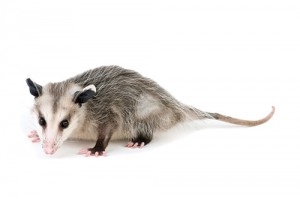
Opossum. Photo courtesy of, and copyrighted by, Gene White, pmimages@earthlink.net
From birth, these American marsupials are cryptic and elusive. Young are born at an early stage of development after a short period in the womb. These notorious-to-be young have rudimentary limbs, closed eyes and no fur. They crawl deceptively to the mother’s pouch to hide, firmly attach to a nipple and feed. Gradually, the young exit the pouch for longer periods to feed, fend and perpetuate family thievery.
Near the top of our wildlife Pest Most Wanted list is the Virginia opossum, Didelphis virginiana (meaning double-wombed). As the largest American marsupial, the perpetrating opossum has expanded rapidly the range of its criminal empire.
The opossum deceptively creates shelter within piles of debris and structures. Further indictments include scavenging omnivore dietary sources such as grubs, eggs, fruits, flowers and carrion. Pleading innocent when threatened, the opossum might feign death (or play possum) for several hours.
Solitary, and moving covertly and nocturnally, the opossum varies in color from grey to red, brown, and black. It has white-tipped guard hair and thick under pelage. A physical description includes a skull length of 3 to 4 in., 50 teeth, a body length of 13 to 20 in., a tail of 10 to 12.5 in and a weight of 4 to 7 lbs. These suspects have an unkempt appearance; a pale, gray-white face; five clawed toes on each foot; and a denuded prehensile (grasping) tail.
Arresting the opossum’s felonious behavior includes intuitive structural exclusion, habitat modification by removing debris cover and plugging
burrows to reduce habitual visits, and humane trapping with box or cage traps (appropriate euthanasia might be required). Occasionally, shooting with a .22 caliber rifle might be appropriate.
Leave A Comment